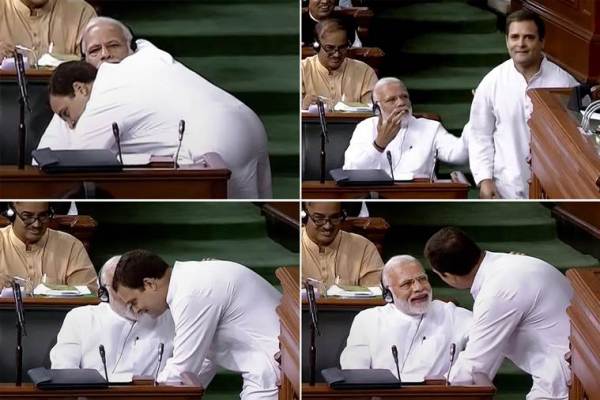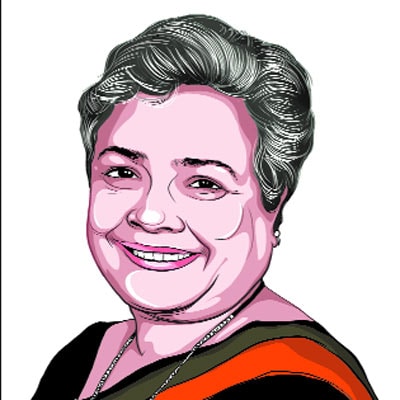A hug runs through it
The embrace in Parliament ushered spontaneity into stuffy corridors of power

Congress president Rahul Gandhi hugs Prime Minister Narendra Modi in the Lok Sabha. (LSTV GRAB via PTI)
Power is generally all high seriousness in Delhi, bereft of levity or inquisitiveness, let alone physical proximity among human beings. No wonder the TV channels, their audience and social media can’t get enough of the rare spectacle that unfolded in Parliament during the recent debate on a no-confidence motion: Rahul Gandhi, having finished his speech, walks calmly across to the Treasury benches and envelopes the prime minister in a tight hug before the latter has had a chance to recover from the surprise.
Fear of breaching borders seems to be encoded in human DNA. In 1958, scientist Harry F Harlow’s group studied a group of rhesus monkeys and concluded that the young ones liked and were calmed by touch, especially from their mother. A minister from the NDA, who recently decried Darwin to say that his ancestors had not descended from apes, may not agree, but most scientists and psychiatrists believe that humans are even more hard-wired to the importance of touch. Each of our fingertips has over 3,000 receptors and studies have confirmed that physical demonstration of affection such as a hug, results in a sudden increase in Oxytocin flow and boosts immunity. It is not surprising that the word hug (perhaps from the Old Norse hugga, to comfort) has been in circulation in the English language since the 16th century. Hindutva supporters would be happy to know (or maybe not) that the Sanskrit word “aalingan”, which means enveloping someone in your arms, is older. The ancient ritualistic hug a Hindu father gives a son at the time of performing any of the (16) coming-of-age samskaras must be accompanied by a mantra that says, “Angad, Angad sparshyaami”(I touch you with my entire physical being).
A question to ponder: Why should old taboos on physical intermingling across gender, caste, class, community or language lines continue within Parliament? Why should thou shalt not try to touch a VIP without prior intimation and clearance, be supported in the name of securing safe spaces? How come the Indian state has allowed various clans, tribes and khap panchayats to enforce borders to inhibit freedom of speech and mobility, particularly of women? How come our electoral politics, instead of challenging these unconstitutional bans and borders, treats caste/clan/tribe leaders as heads of little republics and uses them to capture vote banks?
This is perhaps why a parliamentarian hugging the supreme leader of the ruling dispensation threw open a once impermeable and heavy curtain. And when that happened, despite the stiff corset of the BJP’s power, the media and young viewers realised how they, India’s young, may still salvage and usher into Parliament a spontaneity at once youthful and warm, uninhibited by the chilling atmosphere of a historic red stone building. With that brief glimpse of what was immediately dubbed by the system as a physical breach of (perhaps unwritten) protocol, India suddenly realised that a good 80 per cent of its population is below 40 years of age, and while the streets of today’s India are colourful, crowded, noisy and exotic, our Parliament or the Prime Minister’s office cannot afford to remain a uniform monolithic creation, inaccessible to the media and the voters and audible only through electoral oratory or a few stentorian and over long monologues like Mann ki Baat.
There is a right time for everything. Those who enjoy a good swig know how when a fresh brew is poured into an ancient oak cask, the wood first resists but then slowly yields everything it has: The sun, fragrance and colour the tree had been exposed to over the years. And after three years or so, the brew that has squeezed these juices out of dead wood will begin to mature. And that’s why a young brew needs calm and physical proximity to the barrel. It also needs cross-ventilation and a dry atmosphere, because as it matures, it must continue to breathe.
Finally, when the palate tastes the comforting brew, it will spare a fond thought for the ancient tree out of which the barrel was crafted many summers ago.
The writer is a senior journalist and former chairperson of Prasar Bharati
For all the latest Opinion News, download Indian Express App
More From Mrinal Pande
- Betraying UttaraUttarakhand teacher’s plea, response to it, reveal government’s attitude to educators...
- Tunes of DissentThe mind of an Indian artist who has always called out the wrong notes of a rigid, stratified classical music ecosystem ..
- Lage raho, Naresh bhaiWhen men begin to lose power, they begin to lose control over their speech...







































No hay comentarios:
Publicar un comentario